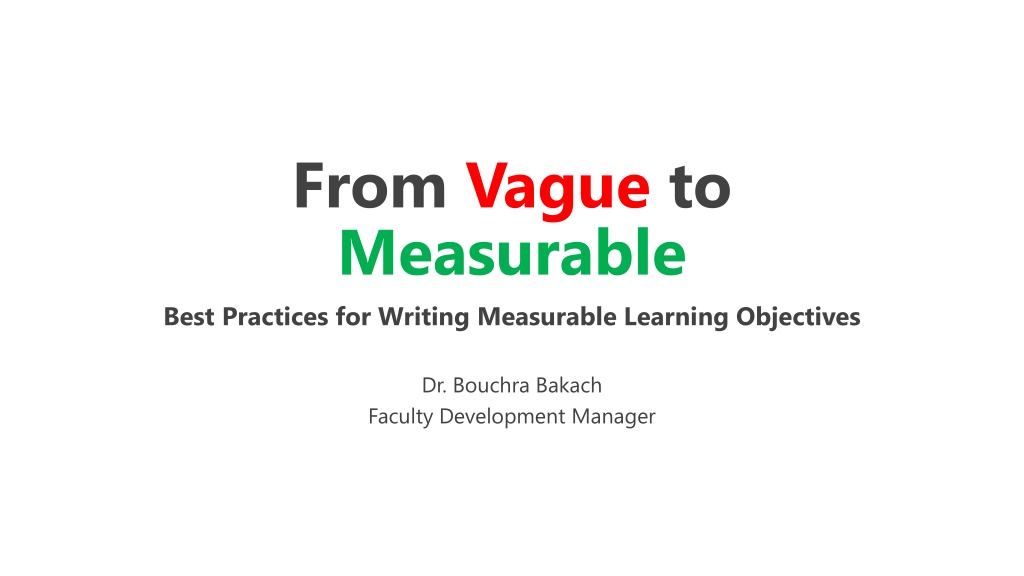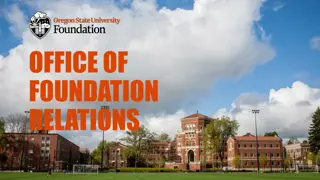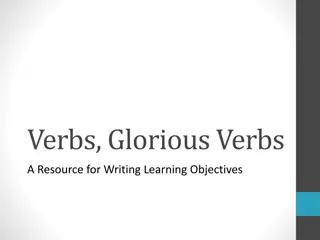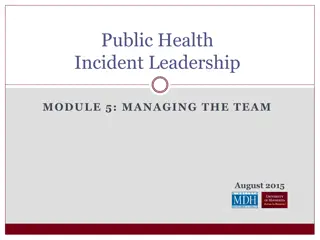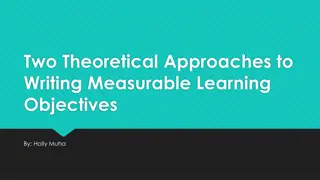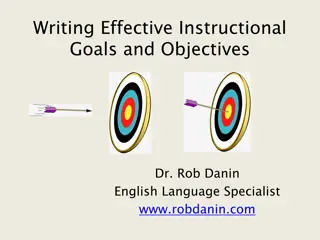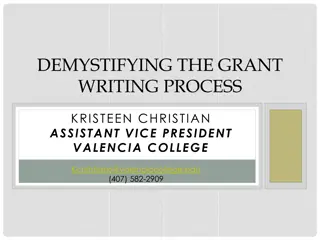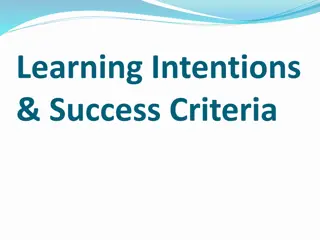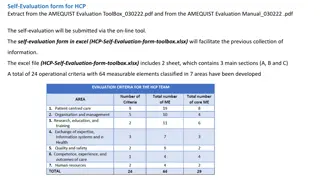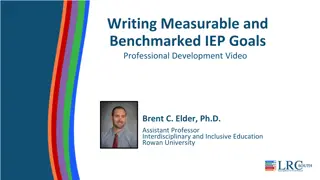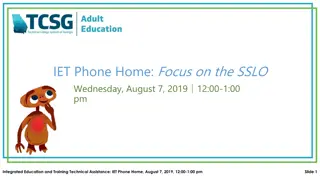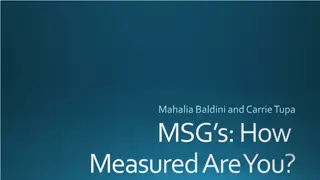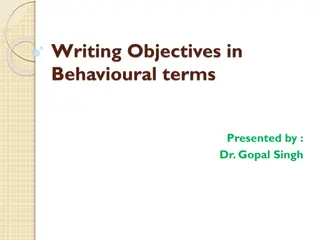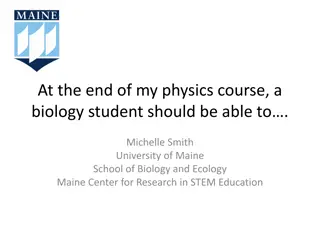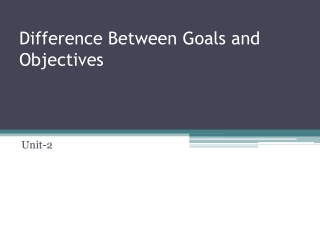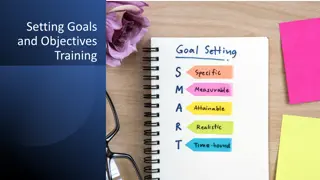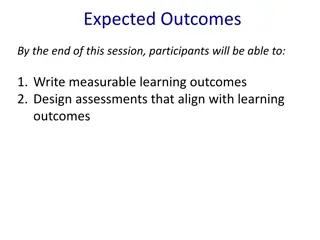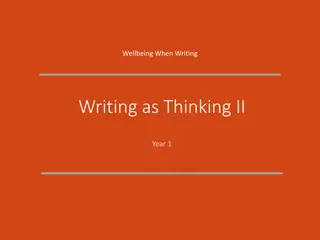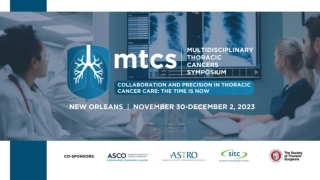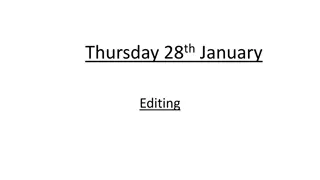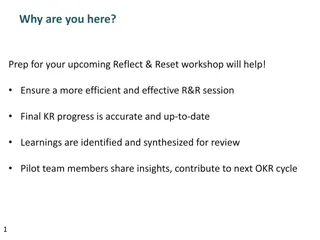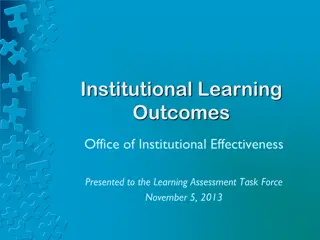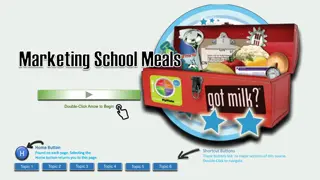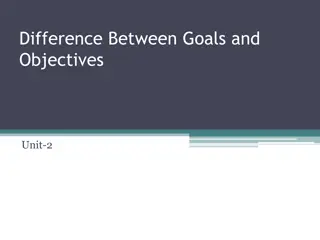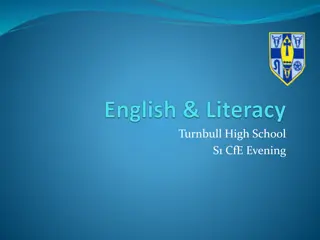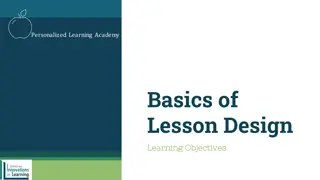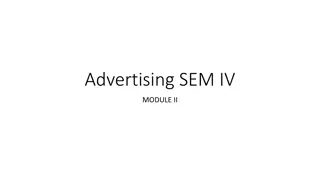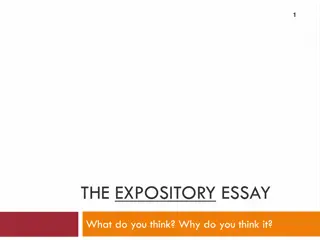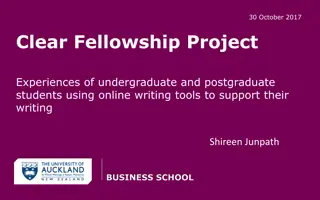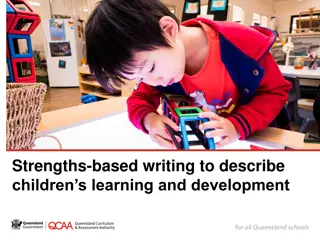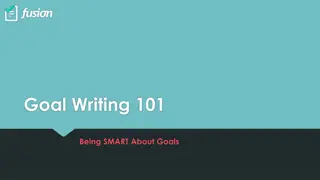Effective Strategies for Writing Measurable Learning Objectives
Learn best practices for transforming vague course outcomes into measurable learning objectives. Dr. Bouchra Bakach provides insights on overcoming challenges in aligning course outcomes with assessments, engaging students in understanding learning objectives, and establishing clear connections to future career paths.
Download Presentation

Please find below an Image/Link to download the presentation.
The content on the website is provided AS IS for your information and personal use only. It may not be sold, licensed, or shared on other websites without obtaining consent from the author. Download presentation by click this link. If you encounter any issues during the download, it is possible that the publisher has removed the file from their server.
E N D
Presentation Transcript
From Vague to Measurable Best Practices for Writing Measurable Learning Objectives Dr. Bouchra Bakach Faculty Development Manager
Polling Questions Please Scan the QR code to answer the three survey questions! https://forms.office.com/r/eVySpVx9FE
Polling Question 1 What challenges do you typically experience when writing course outcomes and learning objectives? (Check all that apply.) I am given course outcomes that I am not allowed to change. My course has a long list of course outcomes, and I find it challenging to address them all. My current course outcomes are very broad or vague. I have to create or revise my course outcomes, and I m not sure where to begin. The assignments and assessments are not closely aligned to my course outcomes. Other
Polling Question 2 About how many students usually ask you to clarify your course outcomes? Almost all of the students About three fourths of the students About half of the students About one fourth of the students Very few students Other
Polling Question 3 What steps do you currently take to help students see the connections between course outcomes, learning objectives, and their future courses or careers? (Check all that apply.) All course assignments, activities, and assessments are clearly mapped on the syllabus or written guidelines to course outcomes and/or learning objectives. I regularly discuss the connections between the course outcomes, learning objectives, and future career skills. Students are asked to write about or report on their progress toward the course outcomes. I indicate each outcome's level of importance for the course. I do not use course outcomes aside from having them on my syllabus as required by my institution. Other
What are Learning Outcomes? Learning outcomes clearly describe what student will know understand and be able to do upon completion of a learning experience or sequence of learning experiences.
Levels of Learning Outcomes Institutional Learning Outcomes (ILOs) Program Learning Outcomes (PLOs) Course Learning Outcomes (CLOs) Week/Unit/Lesson/ Learning Outcomes
Levels of Learning Outcomes Definitions Broad macro-level statement that describe knowledge, skills, abilities and attitudes students are expected to develop as a result of their overall experiences with any aspect of the university regardless of their program of study. Institutional Learning Outcomes (ILOs) Broad Broad, comprehensive statements that describe knowledge, skills, abilities and attitudes students are expected to do, know, or develop by the completion of an entire program of study. Program Learning Outcomes (PLOs) Course Learning Outcomes (CLOs) Specific and measurable statements that define the knowledge, skills, abilities and attitudes learners will demonstrate by the completion of a course. Specific Specific and measurable statements that describe what students will be able to do to successfully complete a unit of instruction and ultimately meet course outcomes. They are the building blocks to the course outcomes. Week/Unit/Lesson Learning Outcomes
Institutional Learning Outcomes (ILOs) Program Learning Outcomes (PLOs) Course Learning Outcomes (CLOS) Week/Unit/Lesson Learning Outcomes
Who Develops the Learning Outcomes? Developed by the educational institution itself, with input from faculty, administrators, and stakeholders. Institutional Learning Outcomes (ILOs) Developed by the program faculty or department, in collaboration with the institution's learning outcomes framework and accreditation standards. Program Learning Outcomes (PLOs) Course Learning Outcomes (CLOS) Developed by program, in alignment with the program and institutional learning outcomes and accrediting agency standards. Week/Unit/Lesson Learning Outcomes Developed by the individual instructor or instructional designer, in alignment with the course and program learning outcomes.
Think-Pair-Share Activity Think for one Minute about this: Course learning outcomes are generally developed by the department/program and approved by the curriculum committee. In order to address all course learning outcomes, what is your strategy and how do you break them down into smaller, more manageable pieces, such as Lesson level learning outcomes? Pair with the person closest to you! Share your answer!
From Course learning Outcomes (CLOs) to Lesson Learning Outcomes (LLOs) Lesson Learning Outcome 1 Lesson Learning Outcome 1 CLO1 CLO4 Lesson Learning Outcome 2 Lesson Learning Outcome 2 Lesson Learning Outcome 3 Lesson Learning Outcome 3 Lesson Learning Outcome 1 Lesson Learning Outcome 1 Course CLO5 CLO2 Lesson Learning Outcome 2 Lesson Learning Outcome 2 Lesson Learning Outcome 3 Lesson Learning Outcome 3 Lesson Learning Outcome 1 Lesson Learning Outcome 1 CLO6 CLO3 Lesson Learning Outcome 2 Lesson Learning Outcome 2 Lesson Learning Outcome 3 Lesson Learning Outcome 3
Example: Calculus 1 CLO1 CLO2 CLO3 Students will be able to differentiate and integrate functions using a variety of techniques Students will be able to apply calculus to solve real-world problems Students will be able to communicate mathematical ideas clearly and effectively Mathematical Language & Notation Optimization problems Limits and continuity Related rates problems Interpretation and explanation of calculus concepts Derivatives Application of Calc. in Sci & Eng. Techniques of integration Developingclear and concise proofs Application of Calc. in Econ & Fin. Application of Derivatives Collaborating and communicating with peers Application of Calc. in other Fields Application of Integrals Using technology to aid in communication
Example: Calculus 1 CLO1 Students will be able to differentiate and integrate functions using a variety of techniques Limits and continuity Students will be able to evaluate limits of functions at a point and at infinity using algebraic techniques and limit laws. Students will be able to determine if a function is continuous at a point or on an interval and identify types of discontinuities. Students will be able to apply the intermediate value theorem and the extreme value theorem to find maximum and minimum values. Differentiation rules (power, product, quotient, chain, and trigonometric rules) Students will be able to apply the power rule, product rule, quotient rule, and chain rule to differentiate functions. Students will be able to use the trigonometric differentiation rules to differentiate functions involving trigonometric functions. Students will be able to use implicit differentiation to find the derivative of a function that is not explicitly defined. Implicit differentiation
Example: Chemistry 101 Students will be able to demonstrate an understanding of the concept of gas pressure ?????????????????????? ????????????????????? 1. Understanding of the concept of gas pressure = performing pressure unit conversions??!! 2. Understanding of the concept of gas pressure = describing how a barometer works??!! 3. Understanding of the concept of gas pressure = knowing the relationship between temperature and pressure ??!! 4. ??!! 5. ??!!
Example: Chemistry 101 1. Reword the goal of understanding the concept of gas pressure" into a set of relevant topics/objectives: Convert gas pressure values among all relevant units Predict the effect of temperature on gas pressure Predict the effect of altitude on gas pressure List the barometer functions involved in atmospheric pressure measurements
2. Turn the objectives into SMART Objectives: Converting gas pressure values among all relevant units Students will be able to convert between different units of pressure, such as pascals, atmospheres, millimeters of mercury, and pounds per square inch. Systematically predicting the effect of temperature on gas pressure Students will be able to explain how temperature affects the kinetic energy of gas particles and use this knowledge to predict the effect of changes in temperature on gas pressure, as well as calculate the new pressure values. Systematically predicting the effect of altitude on gas pressure Students will be able to explain how altitude affects atmospheric pressure, and use this knowledge to predict the pressure values at different altitudes. Listing the barometer functions involved in atmospheric pressure measurements Students will be able to describe the basic functioning of a barometer and explain how it can be used to measure atmospheric pressure. They will also be able to list the different types of barometers and their applications.
Learning Outcomes/Objectives have Three Components: By the end of this [lesson/session/week/unit/module/course/workshop, etc.], students will be able to .. + Action verb (select the appropriate verb from the Blooms Taxonomy (i.e. list, explain, discuss) + The product (for example: the six stages of the scientific method
Effective Learning Outcomes/Objectives Should be S M A Specific and Student-Centred Should be clear and specific and describe precisely and focus on what the student is expected to be able to do or achieve. Should be measurable and observable, so that the learner's progress can be tracked and evaluated. Measurable Should be feasible within the given learning environment and should use an action verb that represents a specific behavior change or acquisition. Achievable and Action-oriented R Should be relevant to the learner's needs, interests, and career goals, and aligned with the course, program and institutional learning content. Relevant T Time-Bound and Transparent Should state when students should be able to demonstrate the skill and communicate clear deadlines and checkpoints for tracking progress.
Example By the end of this lesson (time-bound and transparent), students (Student-centered) will be able to define (Achievable and Action-oriented) the six major classes of nutrients (Specific, Measurable). Relevant Aligned with the students needs, level, course learning outcomes: CLO1 -Identify and explain the major classes of nutrients and their role in maintaining health and preventing disease.
Let's Practice Improve the following learning outcomes/objectives Poorly Written LOs Issue Well Written LOs Students will learn the programming language, Python. Students will know the elements from the periodic table Students will be able to apply one of the many theories of social psychology and apply those theories to a number of real world situations. Course Objective: Students will be able to construct a sentence in Spanish using correct grammar and punctuation. Learning Objective: Students will identify provinces in Spain on a map The instructor will explain the process of conducting an experiment.
Let's Practice Answers Poorly Written LOs Issue Well Written LOs Students will learn the programming language, Python. Vague Clear and specific: Students will use the programming language, Python, to complete a data mining analysis. Students will know the elements from the periodic table Unmeasurable Measurable: Students will be able to identify the elements from the periodic table based on their symbols Students will be able to apply one of the many theories of social psychology and apply those theories to a number of real world situations. Too wordy Concise: Students will be able to apply theories of social psychology to real world situations. Course Objective: Students will be able to construct a sentence in Spanish using correct grammar and punctuation. Learning Objective: Students will identify provinces in Spain on a map Irrelevant, unaligned Aligned and relevant: Course Objective: Students will be able to construct a sentence in Spanish using correct grammar and punctuation. Learning Objective: Students will be able to conjugate verbs correctly in the past tense. The instructor will explain the process of conducting an experiment. Non-student- centered Student-centered: Students will be able to create their own experiments to test a hypothesis.
Benefits of Learning Outcomes for Instructors Focus teaching and learning activities on specific knowledge, skills, and attitudes that are most important. Intentional Course Design Develop targeted learning activities and assessments that closely align with the intended learning outcomes. Alignment Makes the evaluation of student learning and the design of assessment tools/strategies easy. Ease of Assessment Clearly communicates course expectations to students and fosters effective dialogue among all stakeholders. Communication Aid continuous improvement in teaching strategies and content through self-evaluation and reflection.. Reflection
Course Learning Outcomes Domain Lesson Learning Outcomes Learning Activities Assessment Define the six major classes of nutrients and describe the chemical composition of each. Lecture YouTube video: XYZ In-class activity Quiz CLO1: Identify and explain the major classes of nutrients and their role in maintaining health and preventing disease. Knowledge, Cognitive skills Identify the functions of each nutrient class in the body, including providing energy, building and repairing tissues, and regulating metabolic processes. Lecture Website: XYZ In-class group activity Quiz Explain the importance of a balanced diet that includes all six nutrient classes for maintaining good health and preventing chronic Lecture Case study In-class group activity Quiz Homework
Benefits of Learning Outcomes for Students Provide students with clear expectations of what they are expected to learn and achieve. Clear Expectations Motivate students to put in the efforts of what they are expected to learn and to achieve. Motivation Help students see how courses or the different parts of a course relate to each other and fit together. Coherence Enables students to assess own progress and identify areas where they need to focus more attention or seek additional support. Self-Assessment Foster a sense of accountability and ownership of learning when understanding what is expected to be learned and achieved.. Accountability
Mistakes to avoid when writing learning outcomes DO DON T Focus on students and think about what they will be able to do or understand by the end of the lesson or course Don t focus on you and on what you will cover!
Mistakes to avoid when writing learning outcomes DO DON T Avoid forbidden vague verbs such as: understand, appreciate, learn, gain insight, know, become acquainted with, realize, recognize, internalize, believe. etc.! Use more specific and measurable verbs that indicate a concrete action or outcome such as "write," "solve," or "interpret, , etc
Mistakes to avoid when writing learning outcomes DO DON T Avoid "Elementitis" listing the topics or elements covered in the course, without providing any context or understanding of how these topics are connected or how students can use this knowledge. Create focused and connected learning outcomes using action verbs to describe specific skills or knowledge, while showing how they contribute to achieving the overall course goals.
Mistakes to avoid when writing learning outcomes DO DON T Don t always aim for mastery Don't set unrealistic or unattainable learning outcomes or overlook the needs and abilities of students when designing learning outcomes and teaching materials. Use Bloom's Taxonomy to identify the appropriate level of thinking skills required for the course outcomes, and design learning outcomes, teaching material and assessment activities that align with that level and student needs.
Mistakes to avoid when writing learning outcomes DO DON T Avoid multiple verbs and objects, example: Students will identify possible safety hazards, use protective equipment and maintain a safe work environment. Choose the verb that matches the highest level of learning that students can reasonably be expected to achieve in the course/program/activity/service. Example: Students will maintain a safe work environment.
Mistakes to avoid when writing learning outcomes DO DON T Don t Avoid Outcomes that May be Difficult to Measure Include learning outcomes that focus on developing soft skills and values even if they are difficult to measure and evaluate them using assessment tools such as written reflections, observations, or surveys.
Mistakes to avoid when writing learning outcomes DO DON T Don t Avoid Outcomes that May be Difficult to Measure Include learning outcomes that focus on developing skills, values, and self- awareness, even if they are difficult to measure. Use assessment tools such as written reflections, observations, or surveys to evaluate these outcomes.
Mistakes to avoid when writing learning outcomes DO DON T Don t use learning outcomes only as a checklist for grading or evaluation purposes. Follow-through: It's important for instructors to not only write effective learning outcomes, but to also use them throughout the course to guide teaching and assessment.
Mistakes to avoid when writing learning outcomes DO DON T Don t assume that students will automatically meet the learning outcomes without proper guidance or feedback. Actively communicate with students about the learning outcomes and provide them with regular opportunities to assess their progress and receive feedback..
Reviewing Learning Outcomes/Objectives Guiding Question Yes No Will the student know exactly what they are expected to know and do if they were to read the learning outcome? Can the learning outcome be measured through assessment (formative or summative) and evaluation methods? Will students be able to reach the expectations conveyed in your learning outcome? Is the content described in the learning outcome relevant to student's needs, interest, career goals..? Is the learning outcome aligned with course and program Learning Outcomes? Can the learning outcome be met within available time constraints?
In Summary, Learning Outcomes/Objectives Should be Clear and specific stating exactly what the learner is expected to achieve. Measurable so that the learner's progress can be tracked and evaluated. Aligned with assessment methods used to evaluate learner progress. This makes it clear to learners how their progress will be assessed and what they need to do to succeed. Communicated clearly to learners, through course materials, syllabi, or other means. This ensures that learners are aware of the objectives/outcomes from the start of the course or program. Revisited regularly to ensure that learners are on track to achieve them and to make any necessary adjustments to the course or program.
